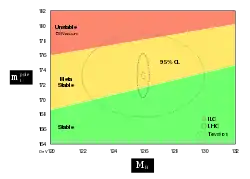宇宙的終極命運
宇宙的終極命運是物理宇宙學中一個主要的議題。許多科學理論都對宇宙的命運作出預測並成為競爭的對手,包括未來與時間是有限還是無限。
| 本条目所属系列 |
| 物理宇宙学 |
|---|
|
自從宇宙起源於大爆炸並經歷暴脹的概念為大多數科學家接受之後[1],宇宙的終極命運就成為宇宙論可以探討的問題,取決於物理上的性質:在宇宙中的質量/能量,它們的平均密度和膨脹速度。
脫穎而出的科學基礎
宇宙的形狀

根據天文觀測和宇宙學理論,可以對可觀測宇宙未來的演化作出預言。均勻各向同性的宇宙的膨脹滿足1930年代所提出的FLRW度規。根據這一方程(不考慮暗能量的時候),物質的引力會導致宇宙的膨脹減速。宇宙的最終命運決定於物質的多少:如果物質密度超過臨界密度,宇宙的膨脹最後會停止,並逆轉為收縮,最終形成與大爆炸相對的一個「大擠壓」(英语:Big crunch);如果物質密度等於或低於臨界密度,則宇宙會一直膨脹下去。另外,宇宙的幾何形狀也與密度有關: 如果密度大於臨界密度,宇宙的幾何應該是封閉的;如果密度等於臨界密度,宇宙的幾何是平直的;如果宇宙的密度小於臨界密度,宇宙的幾何是開放的。並且,宇宙的膨脹總是減速的。
然而,上述說法只考慮了物質質量之數量,而並未考慮暗能量的數值,即是只代表了ΩΛ=0而ΩM分別為不同數值的情況。若然ΩΛ也考慮在內的話,開放宇宙(曲率為負)即使Ω<0也可以到達大擠壓,封閉宇宙(曲率為正)即使Ω>0也可以永遠加速膨脹[3]。在ΛCDM模型成立之前提下,相關常數之最新觀測值表示,宇宙曲率接近平坦,膨脹速度則在加速。
宇宙的穩定性
研究宇宙的本質與未來命運已經持续很多年了。描述宇宙的科學模型都會將宇宙的亚稳定性納入考量,也就是說宇宙很可能擁有很長的壽命,但並不是完全穩定,空間某些區域可能在未來某個時刻被摧毀,因此倒塌成為一種更加穩定的真空態。[5]假若能夠更準確地测出希格斯玻色子與頂夸克的質量、標準模型能夠正確地描述粒子的物理行為甚至到普朗刻尺度的極端能量,則可以得知宇宙的現有真空態是否穩定,或仅仅只是长寿[6][7](有時這會被误解為「希格斯玻色子終結了宇宙」[9])。而質量大約在125 – 127 GeV值域內的希格斯玻色子似乎非常接近分割穩定區域與亞穩定區域的邊界。[4]更明確的答案仍需等待更準確地測量頂夸克的极点质量。[4]
假若測量結果建議,宇宙的真空是一種伪真空,則這意味著當今宇宙的作用力、粒子、架構可能不再存在,在幾十億年之後,[10][註 1]可能會被另外一種宇宙(若它能成核)全盤替代。[註 2]準確測量頂夸克質量可能需要新一代高端精密的正負電子對撞機。[4]
注释
- 泡沫可能會在任意位置、任意時間隨機發生,所產生的效應應該會從源發點以光速傳播於宇宙。[11]
- 假若標準模型正確無誤,則當今宇宙所存在的所有基本粒子與基本作用力,之所以能夠擁有其特徵行為與特徵性質,完全是因為到處散佈的基本量子場。它們可以處於狀態有很多種,每一種的穩定性不同,這包括穩定態、不穩定態、亞穩定態(除非攪擾夠大,超過某種閾值,亞穩定態會保持穩定不變)。假設,某種更為穩定的真空態替代了當今的真空態,則當今宇宙的各種粒子與作用力將會發生變化,不同的粒子或作用力會因新的真空態而出現。宇宙的所有物質都會被重新組構。當今宇宙的架構會被新的架構替代,依基本量子場所處的真空態而定。
参考文献
- Wollack, Edward J. . Universe 101: Big Bang Theory. NASA. 10 December 2010 [27 April 2011]. (原始内容存档于2011-05-14).
- Lemaître, Georges. . Annales de la Société Scientifique de Bruxelles. 1927, A47: 49–56. Bibcode:1927ASSB...47...49L. translated by A. S. Eddington: Lemaître, Georges. . Monthly Notices of the Royal Astronomical Society. 1931, 91: 483–490. Bibcode:1931MNRAS..91..483L.
- Ryden, Barbara. . The Ohio State University. : 56.
- Alekhin, Djouadi and Moch, S.; Djouadi, A.; Moch, S. . Physics Letters B. 2012-08-13, 716: 214 [20 February 2013]. Bibcode:2012PhLB..716..214A. arXiv:1207.0980
 . doi:10.1016/j.physletb.2012.08.024. (原始内容存档于2013-04-30).
. doi:10.1016/j.physletb.2012.08.024. (原始内容存档于2013-04-30). - M.S. Turner, F. Wilczek. (PDF). Nature. 1982, 298 (5875): 633–634 [2015-04-15]. Bibcode:1982Natur.298..633T. doi:10.1038/298633a0. (原始内容存档 (PDF)于2016-03-05).
- Ellis, Espinosa, Giudice, Hoecker, & Riotto, J.; Espinosa, J.R.; Giudice, G.F.; Hoecker, A.; Riotto, A. . Phys. Lett. B. 2009, 679 (4): 369–375. Bibcode:2009PhLB..679..369E. arXiv:0906.0954
 . doi:10.1016/j.physletb.2009.07.054.
. doi:10.1016/j.physletb.2009.07.054. - Masina, Isabella. . Phys. Rev. D. 2013-02-12, 87 (5): 53001 [2015-04-15]. Bibcode:2013PhRvD..87e3001M. arXiv:1209.0393
 . doi:10.1103/PhysRevD.87.053001. (原始内容存档于2013-04-14).
. doi:10.1103/PhysRevD.87.053001. (原始内容存档于2013-04-14). - Irene Klotz (editing by David Adams and Todd Eastham). . Huffington Post. Reuters. 2013-02-18 [21 February 2013]. (原始内容存档于2017-09-07).
Earth will likely be long gone before any Higgs boson particles set off an apocalyptic assault on the universe
- For example, Huffington Post/Reuters[8]
- Boyle, Alan. . NBC News' Cosmic log. 2013-02-19 [21 February 2013]. (原始内容存档于2013-02-21).
[T]he bad news is that its mass suggests the universe will end in a fast-spreading bubble of doom. The good news? It'll probably be tens of billions of years
. The article quotes Fermilab's Joseph Lykken: "[T]he parameters for our universe, including the Higgs [and top quark's masses] suggest that we're just at the edge of stability, in a "metastable" state. Physicists have been contemplating such a possibility for more than 30 years. Back in 1982, physicists Michael Turner and Frank Wilczek wrote in Nature that "without warning, a bubble of true vacuum could nucleate somewhere in the universe and move outwards..." - Peralta, Eyder. . npr – two way. 2013-02-19 [21 February 2013]. (原始内容存档于2015-05-04). Article cites Fermilab's Joseph Lykken: "The bubble forms through an unlikely quantum fluctuation, at a random time and place,"
延伸讀物
非小品類
- Adams, Fred; Gregory Laughlin. . Simon & Schuster Australia. 2000. ISBN 0-684-86576-9.
- Barrow, John D.; Gregory Laughlin. . Oxford University Press. 1986. ISBN 0-19-282147-4.
- Chaisson, Eric. . Harvard University Press. 2001. ISBN 0-674-00342-X.
- Davies, Paul. . Basic Books. 1997. ISBN 0-465-03851-4.
- Dyson, Freeman. . Harper Perennial. 2004. ISBN 0-06-039081-6.
- Gardner, James N., 2005, "The Physical Constants as Biosignature: An anthropic retrodiction of the Selfish Biocosm Hypothesis," International Journal of Astrobiology.
- Goldstein, Martin, and Inge F., 1993. The Refrigerator and the Universe. Harvard Univ. Press. Esp. chpt. 15.
- Guth, Alan. . Addison-Wesley. 1998. ISBN 0-201-32840-2.
- Harrison, Edward. . Cambridge University Press. 2003. ISBN 0-521-77351-2.
- Hawking, Stephen. . Bantam. 1998. ISBN 0-553-38016-8.
- Layzer, David. . Oxford University Press. 1991. ISBN 0-19-506908-0.
- Linde, Andrei. . Taylor & Francis. 1990. ISBN 3-7186-0490-6.
- Penrose, Roger. . Alfred A. Knopf. 2004. ISBN 0-679-45443-8.
- Prigogine, Ilya; Isabelle Stengers. . Random House. 1984. ISBN 0-394-54204-5.
- Prigogine, Ilya. . World Scientific Publishing. 2003. ISBN 981-238-508-8.
- Smolin, Lee. . Oxford University Press. 1997. ISBN 0-19-512664-5.
- Smolin, Lee. . Phoenix. 2001. ISBN 0-7538-1261-4.
- Tipler, Frank. . Doubleday. 1994. ISBN 0-385-46799-0.
- Davies, Paul. . Simon & Schuster UK. 1992. ISBN 0-671-71069-9.
- Islam, Jamal Nazrul. . Cambridge. 1983. ISBN 0-521-24814-0.
科幻
- Anderson, Poul. Tau Zero.
- Asimov, Isaac. The Last Question.
- Barrow, John D. Impossibility.
- Baxter, Stephen. Vacuum Diagrams, Deep Future, Manifold: Time, Exultant, and others.
- Modesitt, L. E., Jr. Gravity Dreams.
外部連結
- Baez, J., 2004, "The End of the Universe(页面存档备份,存于)".
- Caldwell, R. R., Kamionski, M., and Weinberg, N. N., 2003, "Phantom Energy and Cosmic Doomsday,(页面存档备份,存于)" Physical Review Letters 91.
- Hjalmarsdotter, Linnea, 2005, "Cosmological parameters."
- George Musser. . Scientific American. 2010, 303 (3): 84–91 [2012-12-25]. PMID 20812485. doi:10.1038/scientificamerican0910-84. (原始内容存档于2012-10-18).
- Vaas, R., 2006, "Dark Energy and Life's Ultimate Future,(页面存档备份,存于)" in Burdyuzha, V. (ed.) The Future of Life and the Future of our Civilization. Springer: 231–247.
- A Brief History of the End of Everything(页面存档备份,存于), a BBC Radio 4 series.
- Cosmology at Caltech.

